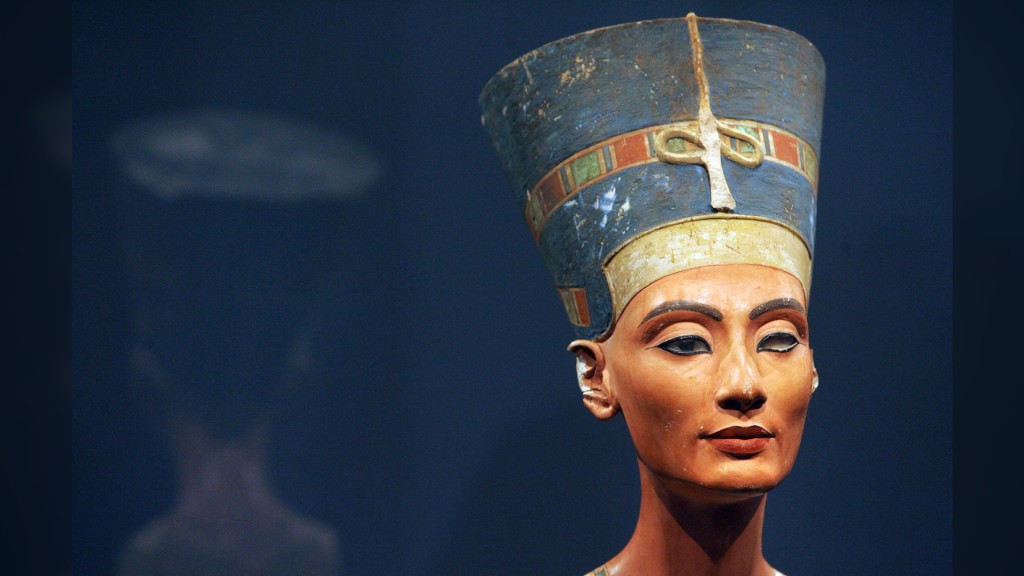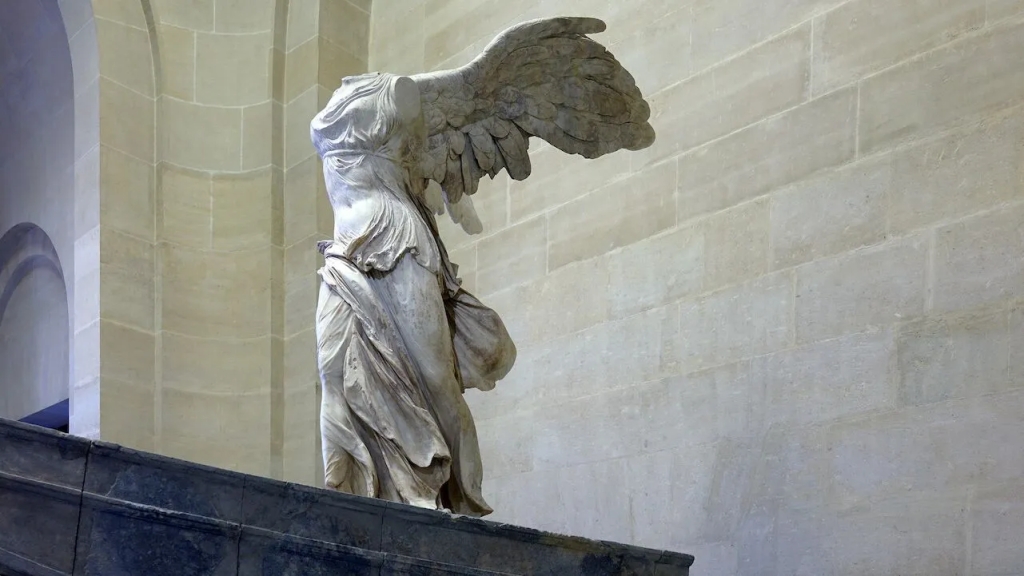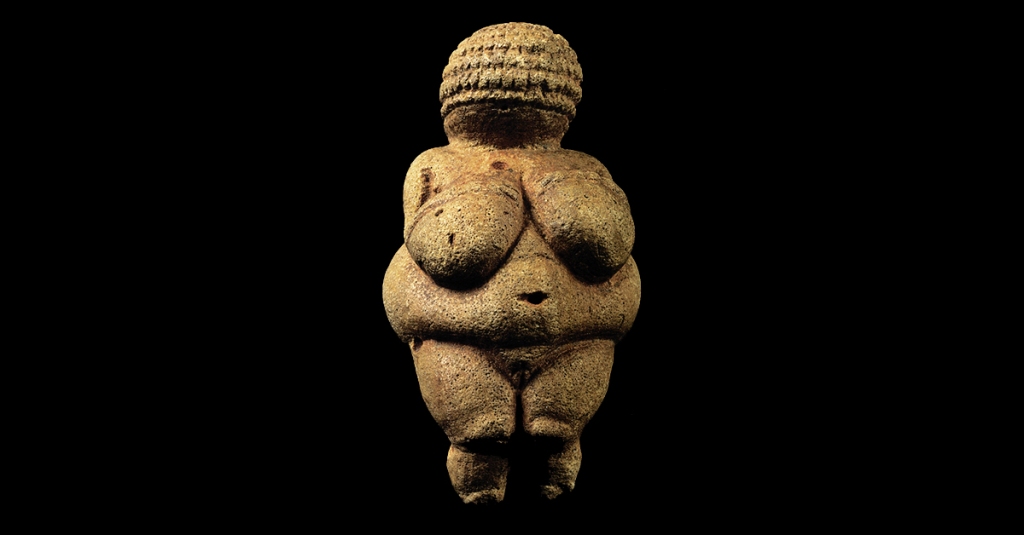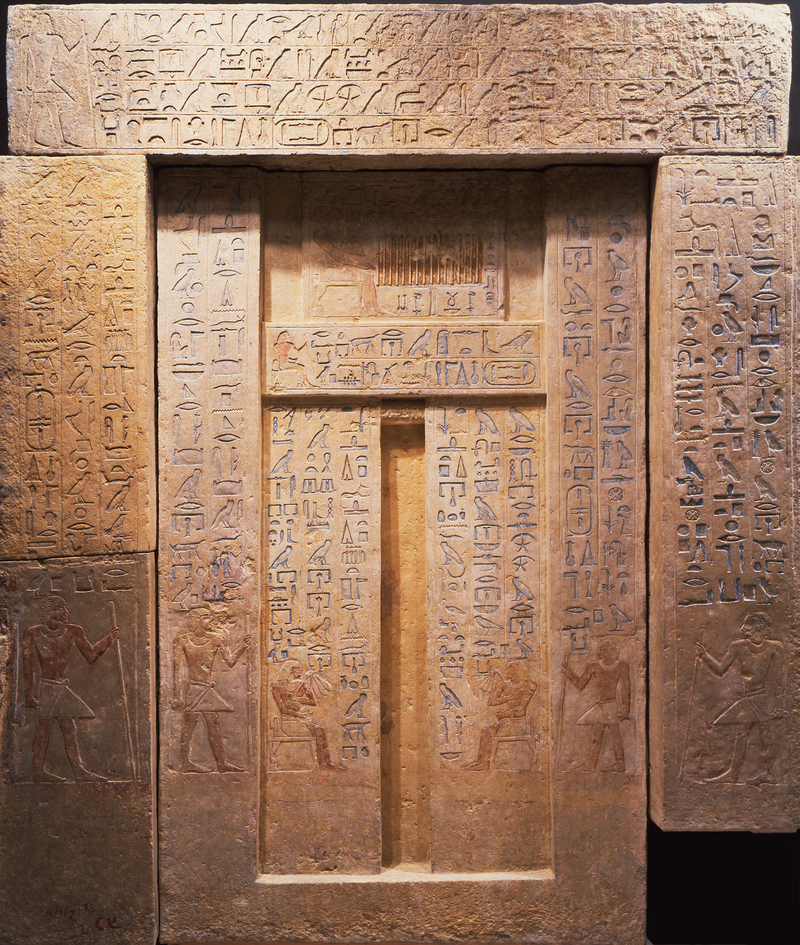
Our second exhibit from Western art is the bust of Nefertiti. How familiar it is, and yet how strange. Nefertiti is the opposite of the Venus of Willendorf. She is the triumph of Apollonian image over the humpieness and horror of mother earth. Everything fat, slack, and sleepy is gone. The Western eye is open and alert. It has forced objects into their frozen frame. But the liberation of the eye has its price. Taut, still, and truncated, Nefertiti is Western ego under glass. The radiant glamour of this supreme sexual persona comes to us from a palace-prison, the overdeveloped brain. Western culture, moving up toward Apollonian sunlight, discards one burden only to stagger under another.
The bust, found by a German expedition at Amarna in 1912, dates from the reign of Akhenaten (1353–36 B.C.). Queen Nefertiti, wife of the pharaoh, wears a wig-crown peculiar to the eighteenth dynasty and seen elsewhere only on Akhenaten’s formidable mother, Queen Tiy. The bust is painted limestone with plaster additions; the eye is inset rock crystal. The ears and uraeus, the royal serpent on the brow, are broken. Scholars have debated whether the piece is a studio model for court artists.
The Nefertiti bust is one of the most popular artworks in the world. It is printed on scarves and moulded in necklace pendants and coffee-table miniatures. But never in my experience is the bust exactly reproduced. The copyist softens it, feminises and humanises it. The actual bust is intolerably severe. It is too uncanny an object for domestic display. Even art books lie. The bust is usually posed in profile or at an angle, so that the missing left pupil is hidden or shadowed. What happened to the eye? Perhaps it was unnecessary in a model and never inserted. But the eye was often chiselled out of statues and paintings of the dead. It was a way of making a hated rival a nonperson and extinguishing his or her survival in the afterlife. Akhenaten’s reign was divisive. His creation of a new capital and efforts to crush the powerful priesthood, his establishment of monotheism and innovations in artistic style were nullified under his son or son-in-law, Tutankhamen, the short-lived boy-king. Nefertiti may have lost her eye in the wreck of the eighteenth dynasty.
As we have it, the bust of Nefertiti is artistically and ritualistically complete, exalted, harsh, and alien. It fuses the naturalism of the Amarna period with the hieratic formalism of Egyptian tradition. But Amarna expressiveness ends in the grotesque. This is the least consoling of great artworks. It’s popularity is based on misunderstanding and suppression of its unique features. The proper response to the Nefertiti Bust is fear. The queen is an android, a manufactured being. She is a new gorgoneion (a representation of a gorgon’s head), a “bodiless head of fright.” She is paralysed and paralysing. Like the enthroned pharaoh Chephren, Nefertiti is suave, urbane. She gazes toward the far distance, seeing what is best for her people. But her eyes, with their catlike rim of kohl, are cold. She is self-divinised authority. Art shows Akhenaten half-feminine, his limbs shrunken and belly bulging, possibly from birth defect or disease. This portrait shows his queen half-masculine, a vampire of political will. Her seductive force both lures in and warns away. She is Western personality barricaded behind its aching, icy line of Apollonian identity.
Nefertiti’s head is so massive it threatens to snap the neck like a stalk. She is like a papyrus blossom swaying on its river reed. The head is swollen to the point of deformity. She seems futuristic, with the enlarged cerebrum foreseen as the destiny of our species. The crown is filled like a funnel with a rain of hierarchic energy, flooding the fragile brain-pan and violently pushing the face forward like the prow of a ship.
Nefertiti is like the Winged Victory of Samothrace, garments plastered back by the wind of history. As cargo, Nefertiti carries her own excess of thought. She is weighed down by Apollonian wakefulness, a sun that never sets. Egypt invented the pillar, which Greece would refine. With her slim aristocratic neck, Nefertiti is a pillar, a caryatid. She bears the burden of state upon her head, rafters of the temple of the sun. The golden brow-band is a ritual bridle, squeezing, constricting, limiting. Nefertiti presides from the temenos of power, a sacred precinct she can never leave.

Venus of Willendorf is all body, Nefertiti all head. Her shoulders have been cut away by radical surgery. Early in its history, Egypt invented the bust, a portrait style still in use. It may have been a robust double, the ka that enters and exits through false doors. The shoulders of the Nefertiti bust have shrivelled to become their own pedestal. No physical force remains. The queen’s body is bound and invisible, like a mummy. Her face gleams with the newness of rebirth. Tense with self-creation, she is a goddess as mother-father. The pregnancy of Venus of Willendorf is displaced upward and redefined. Willendorf is chthonian belly-magic, Nefertiti Apollonian head-magic. Thinking makes it so. Nefertiti is a royal highness, propelling herself like a jet into sky-cult.

Forward thrust. Nefertiti leads with her chin. She has “great bones.” She is Egyptian stone architecture, just as Venus of Willendorf is earthen ovals, woman as quivering poached egg. Nefertiti is femaleness made mathematical, femaleness sublimised by becoming harder and more concrete.
I said Egypt invented elegance, which is reduction, simplification, condensation. Mother nature is addition and multiplication, but Nefertiti is subtraction. Visually, she has been reduced to her essence. Her sleek contoured face is one step from the wizened. She is abbreviation, a symbol or pictogram, a pure idea of pagan pictorialism. One can never be too rich or too thin, decreed the Duchess of Windsor. I said the idea of beauty is based on enormous exclusions. So much is excluded from the Nefertiti bust that we can feel its silhouette straining against the charged atmosphere, a combat of Apollonian line. The name Nefertiti means “The Beautiful One Cometh.” Her haughty face is carved out of the chaos of nature. Beauty is a state of war, a frigid blank zone under siege.
“Nefertiti is ritualised Western personality, a streamlined thing. She is forbiddingly clean. Her eyebrows are shaved and redrawn with male width and frown. She is as depilated as a priest. She has the face of a mannequin, static, posed, self-proffering. Her knowingness is both fashionable and hieratic. The modern mannequin of window or runway is an androgyne, because she is femaleness impersonalized by masculine abstraction. If a studio model, the Nefertiti bust is as much a mannequin as the royal dummy of a London tailor shop. As queen and mannequin, Nefertiti is both exposed and enclosed, a face and a mask. She is naked yet armoured, experienced yet ritually pure. She is sexually unapproachable because bodiless: her torso is gone; her full lips invite but remain firmly pressed together. Her perfection is for display, not for use. Akhenaten and his queen would greet their court from a balcony, the “window of appearance.” All art is a window of appearance. Nefertiti’s face is the Sun of consciousness rising over a new horizon, the frame or mathematical grid of man’s victory over nature. The idolatrous thingness of Western art is a theft of authority from mother nature. Nefertiti’s mismatched eyes, deliberate or accidental, are a symbol of Egyptian duality. Like the cat, she sees in and sees out. She is frozen Apollonian poseur and Gorgonesque daemonic seer. The Greek Graiai, three old divine sisters, had one eye that they passed from hand to hand. Fontenrose connects this to the double pupil of a Lydian queen: “What she had, it seems to me, was a removable eye of wondrous power. It was an eye that could penetrate the invisible. Nefertiti, the half-blind mannequin, sees more by being less. Mutilation is mystic expansion. Modern copyists suppress the missing eye because it is fatal to popular canons of beauty. Maimed eyes seem mad or spectral, as in the veiled vulture’s eye of Poe’s “The Tell-Tale Heart.” Nefertiti is a mutant and visionary materialist, a thing that sees. In Egypt, matter is made numinous by the first electricity of mind. In the Egyptian cult of seeing, Nefertiti is thought in flight from its origins.”
From Venus of Willendorf to Nefertiti: from body to face, touch to sight, love to judgment, nature to society. Nefertiti is like Athena born from the brow of Zeus, a head-heavy armoured goddess. She is beautiful but de-sexed. She is hieratic decorum and reserve, her head literally a reservoir of containment and curtailment, like her stunted torso. Her ponderous, ostentatious crown is the cold breeding ground of Greek categorical thought. Her tight brow-band is stringency, rigor, channelled ideas. The miasmic cloud of mother nature has lifted. Nefertiti’s imperious jutting face is the cutting edge of Western conceptualisation and projection. In her profile, all roads lead to the eye. From the side, diagonals converge in peaking vectors of force. From the front, she rears up like a cobra head, woman as royal intimidator. She is the eye-intense West, the over-enlargement and grandiosity of head culture. The bust of Nefertiti is eye-pleasing but oppressive. It looks forward to Bellini’s androgynous Doge Loredan, to Neapolitan silver reliquary busts, to 1950s fantasy drawings of smiling armless women in chic evening gowns. Authority, good will, aloofness, asceticism. Epiphany as a totem of vibrating passivity. With her welcoming but uncanny smile, Nefertiti is Western personality in its ritual bonds. Exquisite and artificial, she is mind-made image forever caught in radiant Apollonian freeze-frame.
by Camille Paglia 1990

